View in other NatureServe Network Field Guides
NatureServe
Montana
Utah
Wyoming
Idaho
Wisconsin
British Columbia
South Carolina
Yukon
California
New York
Rocky Mountain Grasshopper - Melanoplus spretus
Native Species
Global Rank:
GX
State Rank:
SX
Agency Status
USFWS:
USFS:
BLM:
External Links
General Description
The following comes from Hebard (1928), Brooks (1958), Helfer (1971), Vickery and Kevan (1985), BugGuide (2007), Wikipedia (2020). This was a robust medium to large locust with long wings (tegmina) extending well beyond the abdomen tip. General color was brownish yellow to grayish, with contrasting black markings on the head and lateral lobes of the pronotum. The hind tibia was blue or dark red.
Fascinating resource online here:
The Locust Plague in the United States published 1877.
Phenology
Hatching occurred from mid-May to early June. Adults were reported from July to early October.
Diagnostic Characteristics
The body length to end of forewings of males was 25mm and females 28mm. Head to wing tip 30 to 36+ mm. The long wing was conspicuously spotted and extended beyond the apex of the hind femur 4.5 to 10 mm (Hebard 1928, Brooks 1958, Helfer 1971, Vickery and Kevan 1985, BugGuide 2007, and Wikipedia 2020).
Very similar to the present-day
Migratory Grasshopper, (
M. sanguinipes) and the
Red-legged Grasshopper, (
M. femurrubrum). It has even been suggested that
M. sanguinipes is the non-migratory phase of
M. spretus but has not been substantiated. Molecular studies suggest that
M. spretus may be more closely related to the
Bruner's Spur-throat, (
M. bruneri) than to
M. sanguinipes (Lockwood 2004, and Wikipedia 2020).
Species Range
Montana Range
Range Descriptions
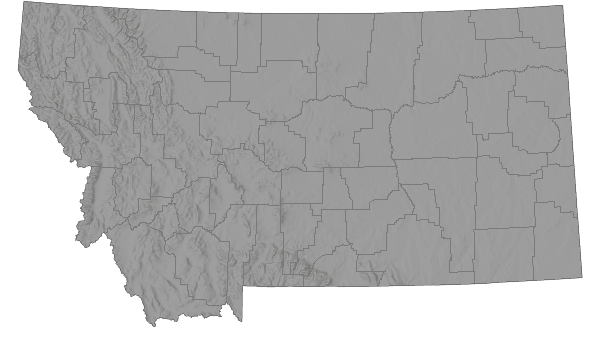
 Historical
Historical
Range Comments
An historic resident in the northern Rocky Mountain region. The Rocky Mountain Grasshopper occurred across Alberta to Manitoba, south to Oregon, Nevada, Utah, Texas, and eastward across the Great Plains states to Minnesota, Iowa, and Missouri (Riley 1877, Helfer 1971, and Vickery and Kevan 1985).
Observations in Montana Natural Heritage Program Database
Number of Observations: 2
(Click on the following maps and charts to see full sized version)
Map Help and Descriptions
Relative Density
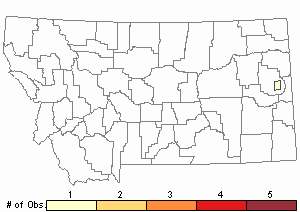
Recency
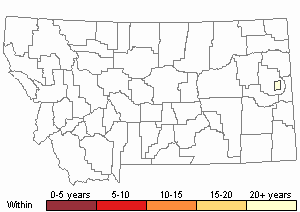
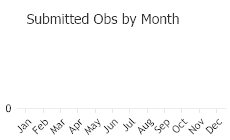
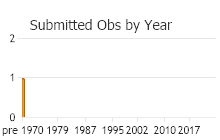
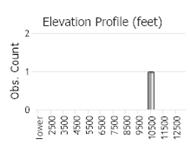 (Observations spanning multiple months or years are excluded from time charts)
(Observations spanning multiple months or years are excluded from time charts)
Habitat
Breeding sites occurred along riverbanks, sunny upland slopes, and subalpine grassy areas. Its true habitat and breeding sites had been established high in the Rocky Mountains while it was still present. It is reported that the species descended from the mountains to the prairies in vast numbers only in certain years, especially in dry and drought seasons following westward wind currents. Outbreaks usually lasted for two consecutive years.
Food Habits
Consumed almost anything including barley, buckwheat, wheat melons, tobacco, strawberries, conifers, apple trees, fence posts, laundry hung out to dry, and even each other (Yoon 2002).
Reproductive Characteristics
The following is taken from BugGuide (2007), Wikipedia (2020), and Vickery and Kevan (1985). It is believed to have bred continuously but only in favorable locations mostly in Montana and Wyoming. In its northern range, only one generation occurred each year. In Texas, a partial second generation had been reported. This species had sedentary and migratory phases. Eggs laid in prairie habitats usually did not thrive. Nymphs behaved gregariously and tended to march during the warm periods of the day, stopping during the evening and early morning. Marching swarms (“hopper bands”) as large as one mile across occurred in 1877. Migratory phases formed immense swarms across the Great Plains in the 1870’s. One swarm in 1875, called “Albert’s swarm) was estimated to 110 miles wide by 1800 miles in length, covering an area of 198,000 square miles-larger than the state of Colorado. This swarm was guessed to contain 12.5 trillion locusts.
Stewardship Responsibility
References
- Literature Cited AboveLegend:
 View Online Publication
View Online Publication
- Additional ReferencesLegend:
 View Online Publication
View Online Publication
Do you know of a citation we're missing? Capinera, J.L., R.D. Scott, and T.J. Walker. 2004. Field Guide to Grasshoppers, Katydids, and Crickets of the United States. Ithaca, NY. Cornell University Press.
Capinera, J.L., R.D. Scott, and T.J. Walker. 2004. Field Guide to Grasshoppers, Katydids, and Crickets of the United States. Ithaca, NY. Cornell University Press. Scott, R.D. 2010. Montana Grasshoppers, Katydids, and Crickets A Pictorial Field Guide to the Orthoptera. MagpieMTGraphics, Billings, MT.
Scott, R.D. 2010. Montana Grasshoppers, Katydids, and Crickets A Pictorial Field Guide to the Orthoptera. MagpieMTGraphics, Billings, MT.
- Web Search Engines for Articles on "Rocky Mountain Grasshopper"
- Additional Sources of Information Related to "Insects"





